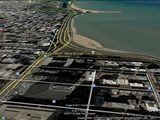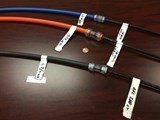Magnificent Mile Micro Trench
Fast back haul is a key ingredient to make small cell installations work. In a city like Chicago the density of buildings makes small cell a natural solution. It just takes a lot of them to get the job done. Line of site still dictates location of the radio receivers and transmitters. But finding the right location is a problem that is easy to solve since most radio/antenna packages can be located on specially constructed street lights.
It is the backhaul that can be a challenge. The existing fiber network may be some distance from the proposed small cell location. In addition, cities are not optimum sites for locating new utilities. The subterranean space is very crowded. City planners like nice streets and with the rapid expansion of telecommunication options, the normal maintenance to sewer, water, gas and electric, it means that city streets are opened more frequently than planners like. Many cities have no choice but to demand that companies and their contractors restore entire intersections, rather than just their opening. This demand also includes thermal striping of walk ways and turn arrows. Restoration, in many cases, can cost more than the job.
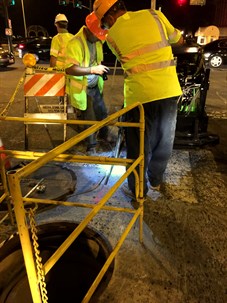
Boring through micro trench and into man hole
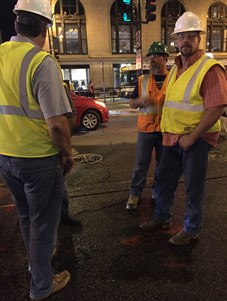
Safety briefing
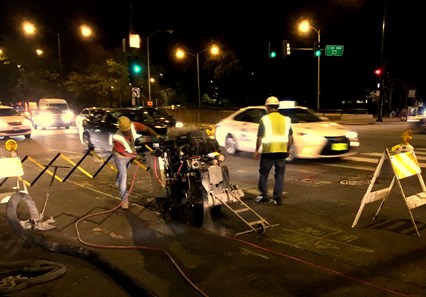
Cutting micro trench
The demand for data in the form of video and audio has pushed the need for extremely fast fiber optic cable right to the small cell radios. Micro trenching offers a minimally invasive way of installing utilities in busy metropolitan areas.
On a recent project, Electric Conduit Construction (ECC), was challenged with placing over 300’ of fiber along the North end of Chicago’s Magnificent Mile. The turn lane had to be closed which meant the work had to take place at night. A quick note about safety. Even a small project in a city forces the project management and safety team to think about what could go wrong. There is a never-ending stream of motor vehicle traffic in the roadway, and pedestrian traffic on every cross walk and on the sidewalks. Spinning saw blades, drills, high pressure water nozzles, and large vacuum trucks add to the confusion and the possibility that someone might get hurt.
To deal with the safety aspect of the project a Safe Work Plan is designed in advance and the entire project execution team understands their role in protecting each other and the public. Every detail is important to maintain the integrity of the work zone protection, and the flow of traffic around the project area. This project was no exception and no incidents occurred.
The micro trench is a saw cut 1.5” wide and 10” deep. Standard utility locating techniques are used before the start of the job. Traffic control is set into place, and all workers must have PPE’s in place. A water-cooled carbide saw is used to make the trench. It takes several passes to saw to the desired depth. The cooling water contains a slurry of bentonite clay to lubricate the cutting tools. The vacuum truck plays an integral role in picking up this slurry from the street. ECC uses straw wattles around the storm sewers to prevent the slurry from leaving the site.
Once the cut is complete residual water is vacuumed out of the cut. At this point sand padding is poured in, then the innerduct is placed in the bottom of the cut, a filler of backer rod is forced into the cut then the remaining five inches is filled with hot epoxy caulking to grade. This forms a seal and load bearing surface. Next a micro-fiber optic cable is blown through the innercut, and terminated or spliced as needed.
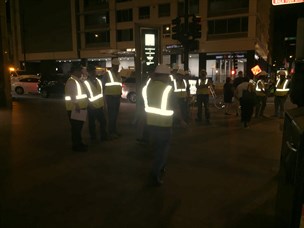
Company engineers observing
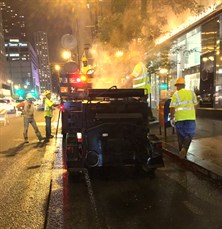
Hot epoxy being applied
Project notes:
- 375' of micro trench
- 1 man hole drill
- Placement of inner duct, backer rod, and hot epoxy sealer
- Blow fiber through the micro duct
- Fiber termination at the small cell radio
- Fiber splicing into the optical network.
That completes the installation. The Micro Trench is a way for cities to minimize construction activities while upgrading telecommunication infrastructure for their businesses and citizens. As small cell installations increase and machine to machine communication proliferates, micro trenching will take on added importance in adding backhaul capability.
Additional photographs
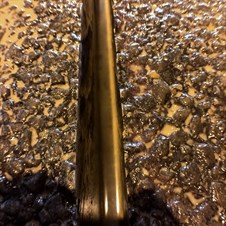
View into micro trench
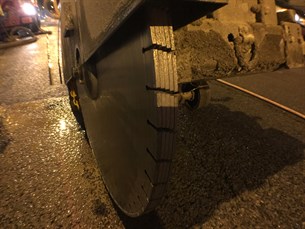
Close up of gang saw

